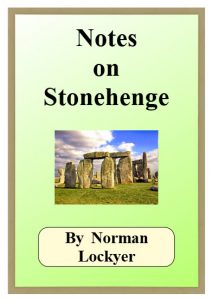IN MY LAST NOTES I REFERRED TO THE STAR OBSERVATIONS WHICH MIGHT BE MADE BY MEANS OF STONE CIRCLES.
I now pass to solar observations.
I have already pointed out that much time has been lost in the investigation of our stone circles, for the reason that in many cases the exact relations of the monuments to the chief points of the horizon, and therefore to the place of sunrise at different times of the year, have not been considered; and when they were, the observations were made only with reference to the magnetic north, which is different at different places, and besides is always varying; few indeed have tried to get at the real astronomical conditions of the problem.
The first, I think, was Mr. Jonathan Otley, who in 1849 showed the “orientation” of the Keswick circle “according to the solar meridian,” giving true solar bearings throughout the year.
I wrote a good deal in Nature[2] on sun and star temples in 1891, and Mr. Lewis the next year expressed the opinion that the British stone monuments, or some of them, were sun and star temples.
Mr. Magnus Spence, of Deerness, in Orkney, published a pamphlet, “Standing Stones and Maeshowe of Stenness[3],” in 1894; it is a reprint of an article in the Scottish Review, October, 1893. Mr. Cursiter, F.S.A., of Kirkwall, in a letter to me dated March 15, 1894, a letter suggested by my “Dawn of Astronomy,” which appeared in that year, and in which the articles which had been published in Nature in 1891 had been expanded, directed my attention to the pamphlet; the observations had no pretension to scientific accuracy, and some of the alignments are wrongly stated, but a possible solar connection was pointed out.
I began the consideration of the Stenness circles and alignments in 1901, but other pressing calls on my time then caused me to break off the inquiry. Quite recently it occurred to me that a complete study of the Stenness circles might throw light on the question of an earlier Stonehenge, so I have gone over the old papers, plotting the results on the Ordnance map.
